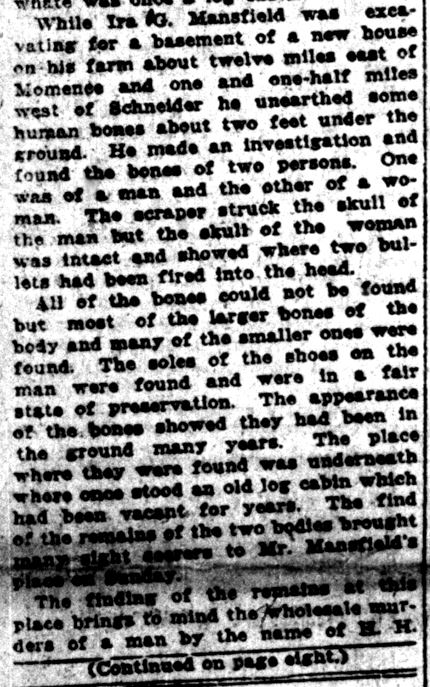In 1873, Mark Twain coined the term “The Gilded Age” to describe a superficially prosperous America undergirded with massive social problems, corruption, even deep wells of horror. One of the more literal terror tales launched onto the front lawns of American newspaper readers in the 1890s was the story of mass murderer H.H. Holmes.
Erik Larson reintroduced us to Holmes in his non-fiction thriller The Devil in the White City in 2003. Larson’s gripping book is a dual history, partly the story of Chicago architect Daniel Burnham, designer of the 1893 World’s Columbian Exposition, and partly the story of Holmes’ “murder castle,” a kind of dark mirror of the expo. At this specially-designed hotel, the “doctor” may have killed up to two-hundred victims, mostly women. Replete with hidden soundproof vaults, a gas chamber, an iron-plated room where Holmes torched people to death, a crematorium, a suffocation room, and other gruesome architectural twists, the World’s Fair Hotel on West 63rd Street in Chicago was a demented perversion of the vaunted celebration of “progress.”
Holmes had been trained at the University of Michigan’s renowned but infamous medical school. Like Indiana medical colleges, Ann Arbor’s was under fire in the late 1800s for supporting the ring of grave-robbers who fed its dissection rooms with corpses ransacked from midwestern cemeteries. Allegedly fascinated with death ever since his childhood friends stuck him in a closet with a skeleton in a New England doctor’s office, Holmes continued to dissect the dead in his gory Windy City hotel — though not for the anatomical instruction of future medical professionals.

Chicago’s worst serial killer had several Indiana connections. One of his better-known victims, Emeline Cigrand, was a beautiful 20-something stenographer from Lafayette whose skeleton Holmes may have sold to Rush Medical College. Nineteenth-century Americans are sometimes called “buttoned up” and guilty of “leaving things in the closet,” but newspapers published details about the doctor’s victims in stories like this one that would probably not be printable in 2015 due to privacy laws. And the cross-over with medical history is disturbing, to say the least.
What might have been Holmes’ last murder — the dismemberment and burning of young Howard Pitezel, son of his main accomplice, Benjamin Pitezel — occurred in Irvington, the Indianapolis neighborhood now famous for its “paranormal activity.” As the Indianapolis Star reported last week in a gossipy news piece, there’s a small chance that actor Leonardo DiCaprio will visit Indiana while filming Martin Scorsese’s new film adaption of The Devil in the White City. The cottage that Holmes briefly rented in the fall of 1894, and where he killed Howard Pitezel before mutilating and burning his body, then sticking part of up it a chimney, sat at the corner of Julian and Bolton Avenues in Irvington. The original house on that site supposedly burned down in the 1930’s, but the cottage there today looks similar.

Philadelphia police detective Frank Geyer and Detective David Richards of the IPD were hot on Holmes’ trail in Indy even before he murdered Pitezel in Irvington a couple of weeks before Halloween. Yet it was three Iocal boys who discovered Howard’s charred bones in the chimney, a find recalled a year later in a long article printed in the Indianapolis Journal called “The Pietzel Bones” (August 22, 1895). After Holmes was finally apprehended, Howard Pitezel’s mother testified before Marion County Coroner Hiram C. Castor. Shown some of the “trinkets” found in the flue, Mrs. Pitezel “went into hysterics” in the Indianapolis courtroom.
H.H. Holmes had tried to start up another “death trap” in Fort Worth, Texas, but he was arrested in Boston in November, 1894, just a month after leaving Irvington. Though put on trial in Philadelphia for killing the Pitezels, he confessed to thirty murders in Chicago, Indianapolis, and Toronto. Like many criminals with huge, almost unbelievable records, Holmes might have been an accomplished liar — he claimed to have been possessed — but his confession was definitely shocking.
While he sat in jail, a fire consumed the macabre World’s Fair Hotel in August 1895, possibly started by a former accomplice. On May 7, 1896, the “arch-fiend,” aged 34, was hanged at Philadelphia’s Moyamensing Prison, a place where another master of spectral gloom, Edgar Allan Poe, had once been imprisoned for public drunkenness.


A few decades after his crimes made it into the press, Chicago’s own Jack the Ripper was slipping out of popular memory. Yet in 1919, a discovery in Lake County, Indiana, brought him back into the news.
In court twenty-four years earlier, Holmes had mentioned killing two people near Schneider, a tiny town on the outskirts of the old Kankakee Marsh in southern Lake County, Indiana’s doomed “Everglades.” The remote spot forty miles south of Gary almost exactly straddled the Indiana-Illinois state line. Back then, it was close to a place called Lineville.
Lineville is obscure, but the papers located it twelve miles east of Momence, Illinois. It must have been a tiny station or railroad switch right on the state line. This was probably the kind of place where trains took on duck meat and frog legs hunted in the swamp to be cooked up for breakfast in the dining cars or sold at the Water Street Market in Chicago. Lineville, Indiana, isn’t on the map today and was apparently “ghosted” more than a century ago.
The identity of Holmes’ alleged victims is a more interesting mystery than Lineville’s disappearance. In October 1919, two skeletons turned up on Ira G. Mansfield’s farm. This clip, published on October 22 in Hammond’s Lake County Times (currently being digitized by Hoosier State Chronicles) must have reminded many readers of the grisly string of murders that rocked the dark underbelly of the heartland back in the 1890s.







